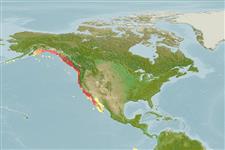Environment: milieu / climate zone / depth range / distribution range
Ecología
marino demersal; rango de profundidad 18 - 800 m (Ref. 6793). Temperate
Eastern Pacific: Chirikof Island in the western Gulf of Alaska to Point Loma and Cortez Bank, southern California, USA.
Tamaño / Peso / Age
Maturity: Lm ? range ? - ? cm
Max length : 27.0 cm TL macho / no sexado; (Ref. 2850)
Short description
Claves de identificación | Morfología | Morfometría
Espinas dorsales (total) : 9 - 11; Radios blandos dorsales (total) : 15 - 18; Espinas anales: 0; Radios blandos anales: 13 - 15. Caudal fin fanned out, bluntly rounded; pelvic fins small, extending about one-third distance to anal origin (Ref. 6885). Color olive green to light brown on dorsal surface, creamy yellow to light brown on ventral surface, 4 dark saddles across back, bars of dark blotches on all fins except pelvic and anal fins; sometimes dusky along margin of anal fin; males sometimes variously blotched with orange to red; silvery areas anterior to and behind base of pectorals (Ref. 6885).
Commonly found on sand and mud bottoms (Ref. 2850). Feeds on crustaceans, including shrimps and isopods (Ref. 6885).
Life cycle and mating behavior
Maturities | Reproducción | Spawnings | Egg(s) | Fecundities | Larva
Eschmeyer, W.N., E.S. Herald and H. Hammann, 1983. A field guide to Pacific coast fishes of North America. Boston (MA, USA): Houghton Mifflin Company. xii+336 p. (Ref. 2850)
IUCN Red List Status (Ref. 130435)
Threat to humans
Harmless
Human uses
Herramientas
Special reports
Download XML
Fuentes de Internet
Estimates based on models
Preferred temperature (Ref.
123201): 5.9 - 8.8, mean 7.1 °C (based on 53 cells).
Phylogenetic diversity index (Ref.
82804): PD
50 = 0.5005 [Uniqueness, from 0.5 = low to 2.0 = high].
Bayesian length-weight: a=0.00676 (0.00300 - 0.01523), b=3.17 (2.98 - 3.36), in cm total length, based on LWR estimates for this (Sub)family-body shape (Ref.
93245).
Nivel trófico (Ref.
69278): 3.5 ±0.56 se; based on food items.
Resiliencia (Ref.
120179): Bajo, población duplicada en un tiempo mínimo de 4.5-14 años (Preliminary K or Fecundity.).
Fishing Vulnerability (Ref.
59153): Low vulnerability (17 of 100).
